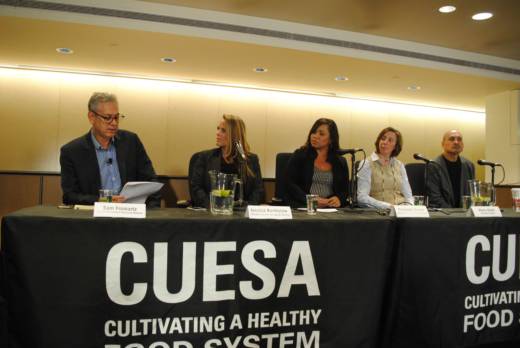But even if they’re eligible for support, many people are hesitant to sign up for it due to heightened fear about Trump’s immigration policies. “Immediately following the election, we had people calling us not to ask for help signing up with CalFresh (California’s food assistance program) or SNAP,” but for help cancelling their benefits, said Elizabeth Gomez, associate director of client services at the Alameda County Community Food Bank, which serves over 300,000 people annually, or one of five residents in Alameda County. The bank fielded at least 40 such calls in the first few weeks after Trump was elected, something Gomez said had never happened before.
Some people are afraid that, by signing up, they will be added to a national database and tracked down by immigration services if they or someone in their family is undocumented. Many also fear that by receiving food assistance they would count as a “public charge,” and thus be disqualified for ever earning citizenship, which Gomez said is one of the many mistruths that shadows food assistance. She made clear that applicants do not have to offer up proof of citizenship or even their names to receive emergency food assistance, and doing so doesn’t bar them from becoming a citizen later on.
At least not yet, noted Bartholow, but the Trump administration is considering adding food benefits and healthcare to the list of government services that designate someone a “public charge.”
It’s a sad irony that the double threat of deportation and hunger often comes down hardest on farmworkers, 50-70 percent of whom are undocumented, said Alexis Guild, senior health policy analyst at Farmworker Justice. There are many reasons the people who grow our food don’t have enough to eat themselves, she explained, including low wages and the fact that most live in rural areas with little transportation and few grocery stores. Farmworkers often rely on employers for housing, which often lacks proper refrigeration or food storage. “So if they’re able to go to a food bank how are they supposed to store the food? How can they protect food from insects or rodents that are in the housing?” she asked.
But even if programs like SNAP are a lifeline, they also are wrapped up on larger systemic problems.
The federal nutrition program is far from altruistic, argued panelist Ricardo Salvador, director and senior scientist at the Union of Concerned Scientists. Grocery stores, he noted, were some of the loudest proponents for establishing a federal food assistance program in its early days, because they saw the money to be made by tapping into the low-income market.
“I think it really is important to understand the big picture,” said Salvador, explaining that the reason so many Americans are hungry isn’t accidental — it’s a matter of oppressive policies, steeped in racism, many of which date back to the country’s beginning. “People are hungry because they’re poor, and people are poor because they aren’t allowed to accumulate wealth,” he said. “They’re poor because we actually … allow certain people to be exploited.”
According to Salvador, the victims of this system are largely people of color. It’s not a coincidence, he says, that farming is the whitest labor in the country and farm labor is the brownest. The descendents of people who worked the country’s land as slaves, or who were forced to surrender it to European settlers, today live with poverty rates much higher than whites. Native Americans, Salvador said, experience three times the poverty rates of whites, while rates for blacks and Latinos are twice as high as for whites. The problems that spur hunger are deep and entrenched, going back well before Trump.
“In spite of the myths of the great social progress of the country,” said Salvador, “what we’re seeing is the truth about the country that’s always been there, simply unmasked.”
When it came to solutions, the panelists conceded that there are no easy ones. But they all start with making sure that the poor, especially farmworkers, earn a living wage and are compensated fairly for their skills and knowledge—an acknowledgment of the value of their work.
That compensation should include a path to citizenship, said Guild, from Farmworker Justice. She urged the audience to oppose programs that would allow farm labor into the country under a temporary guestworker status, noting: “We are a nation of immigrants, not guestworkers. They should have the opportunity to become citizens.”
Gomez, from the Alameda County Food Bank, said that more needs to be done to educate the poor in communities about how they can get help and what their rights are. Voters, she insisted, also need to protect programs like SNAP and WIC from cuts.
“Don’t fall for half truths,” said Bartholow. “When somebody says that nobody who is working a full time job should go hungry, rebut with nobody should go hungry.”
Watch the replay of the live stream for The Empty Plate: Fighting Hunger in the Age of Trump.
CORRECTION: This item was corrected to show Alameda County Community Food Bank serves over 300,000 people annually. It also makes clear that applicants do not have to offer up proof of citizenship or even their names to receive emergency food assistance. However, for SNAP benefits, applicants must provide the names of people in their household and proof of citizenship or legal residency.
